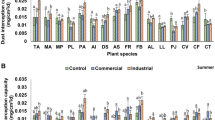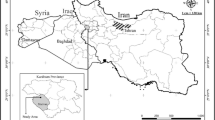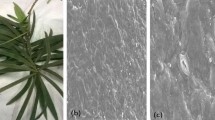Abstract
Purpose
Air pollution is a serious health problem throughout the world, exacerbating a wide range of respiratory and vascular illnesses in urban areas. The mass artificial plantation is very helpful to absorb dust and reduce pollution for conservation of the urban environment. The foliar surface of plants is an important receptor of atmospheric pollutants. Therefore, selection of suitable plant species for urban environment is very important.
Methods
The dust-retaining capability of urban trees in Guangzhou was determined at four different types of urban area, and the morphological traits of their leaves such as wax, cuticle, stomata, and trichomes were observed under a scanning electron microscope.
Results
It was determined that the dust-retaining capability of any given tree species is significantly different in the same place. Of the four studied tree species in the industrial area (IA) and commercial/traffic areas (CTA) type urban areas, the highest amounts of dust removed by Mangifera indica Linn was 12.723 and 1.482 g/m2, respectively. However, in contrast, the equivalent maxima for Bauhinia blakeana is only 2.682 g/m2 and 0.720 g/m2, respectively. Different plant species have different leaf morphology. The leaf of M. indica has deep grooves and high stomata density which are in favor of dust-retained, and thus, their dust-retained capability is stronger, while B. blakeana has the cells and epicuticular wax with its stomata arranging regularly, resulting in poor dust catching capability. Leaf size was also shown to be related to dust capture for the four studied tree species.
Conclusions
The dust removal capacity of individual tree species should be taken into account in the management of greening plantation in and around an urban area. It was also shown that temporal variation in dust accumulation occurred over the 28-day observation period and this was discussed. Furthermore, spatial contrasts in dust accumulation were evidenced by the data. This reflected the differing pollution loadings of the four urban-type areas. The highest amount of dust accumulation was associated with the industrial area in which shipyard and steelworks occurred whilst the lowest dust accumulation was associated with the grounds of the University which was the control area.




Similar content being viewed by others
References
Beckett KP, Freer-Smith PH, Taylor G (1998) Urban woodlands: their role in reducing the effects of particulate pollution. Environ Pollut 99:347–360
Beckett KP, Freer-Smith PH, Taylor G (2000) The capture of particulate pollution by trees at five contrasting UK urban sites. Arboricultural J 24:1–21
Brack CL (2002) Pollution mitigation and carbon sequestration by an urban forest. Environ Pollut 117(S1):195–200
Cai YH (2010) Study on dust-retention effect and photosynthetic characteristics of urban keynote tree. Fujian Agriculture and Forestry University (in Chinese), Fuzhou, Fujian, China
Cavanagh JE (2008) Influence of urban trees on air quality in Christchurch; preliminary estimates LC0708/097. Landcare Research, Lincoln, NZ
Cavanagh J, Zawarreza P, Wilson J (2009) Spatial attenuation of ambient particulate matter air pollution within an urbanised native forest patch. Urban For Urban Green 8:21–30
Chai YX, Zhu N, Han HJ (2002) Dust removal effect of urban tree species in Harbin. Chin J Appl Ecol 13(9):1121–1126 (in Chinese)
Chen W, He XY, Zhang Y, Sun Y, Wang WF, Ning ZH (2003) Dust absorption effect of urban conifers in Northeast China. Chin J Appl Ecol 14(12):2113–2116 (in Chinese)
Freer-Smith PH, Holloway S, Goodman A (1997) The uptake of particulates by an urban woodland: site description and particulate composition. Environ Pollut 95(1):27–35
Gao JH, Wang DM, Zhao L (2007) Airborne dust detainment by different plant leaves: taking Beijing as an example. J Beijing For Univ 29(2):94–99
Guo W, ShenTu YJ, Zheng SQ, Wang W, Liu CF (2010) Research advances on mechanisms and rules of dust retention of the urban green areas. Ecol Environ Sci 19(6):1465–1470, (in Chinese)
Jiang HW, Zhu XD, Sun ZH (2003) Study on dust-blocking effect of Suzhou highway greening. J Fujian For Sci Technol 33(4):95–99 (in Chinese)
Li HM, Liu X (2008) Relationships between leaf epidermal morphology and dust retaining capability of main garden trees in Chengyang District of Qingdao City. Chin J Ecol 27(10):1659–1662 (in Chinese)
Lin D (1976) Air pollution—threat and responses. Addison, London
Liu RT, Bi RC, Zhao HL (2008) Dust removal property of major afforested plants in and around an urban area. Ecol Environ Sci 17(5):1879–1886
Mcdonald AG, Bealey WJ, Fowler D, Dragosits U, Skiba U, Smith RI, Donovan RG, Brett HE, Hewitt CN, Nemitz E (2007) Quantifying the effect of urban tree planting on concentrations and depositions of PM10 in two UK conurbations. Atmos Environ 41:8455–8467
Nilsson KS, Vries D, Sangster M, Seeland K, Gallis C, Schipperijn J et al (2011) Forests, trees and human health: measuring health benefits of green space in economic terms, 13th edn. Springer, New York, p 394
Nowak DJ, Klinger L, Karlic J et al (2000) Tree leaf area-leaf biomass conversion factors Unpublished data USDA forest service, Syracuse, NY
Nowak DJ, Daniel EC, Stevens JC (2006) Air pollution removal by urban trees and shrubs in the United States. Urban For Urban Green 4:115–123
Prusty BAK, Mishra PC, Azeez PA (2005) Dust accumulation and leaf pigment content in vegetation near the national highway at Sambalpur, Orissa, India. Ecotoxicol Environ Saf 60:228–235
Qiu Y, Guan DS, Song WW, Huang KY (2009) Capture of heavy metals and sulfur by foliar dust in urban Huizhou, Guangdong Province. China Chemosphere 75:447–452
Rai A, Kulshreshtha K, Srivastava PK, Mohanty CS (2010) Leaf surface structure alterations due to particulate pollution in some common plants. Environmentalist 30:18–23
Ratnesh T, Chakraborty MK, Tewary BK (2009) Dust dispersion modeling using fugitive dust model at an opencast coal project of Western Coalfields Limited, India. J Sci Ind Res 68:71–78
Rawat JS, Banerjee SP (1996) Urban forestry for improvement of environment. J Energy Environ Monit 12(2):109–116
Smith WH (1977) Removal of atmospheric particulates by urban vegetation: implications for human and vegetative health The Yale. J Biol Med 50:185–197
Wang YC (2011) Carbon sequestration and foliar dust retention by woody plants in the greenbelts along two major Taiwan highways. Ann Appl Biol 159:244–251
Wang HX, Shi H, Li YY (2010) Relationships between leaf surface characteristics and dust-capturing capability of urban greening plant species. Chin J Appl Ecol 21(12):3077–3082 (in Chinese)
World Health Organisation (WHO) (1999) Health costs due to road traffic-related air pollution. WHO, Copenhagen
Yang J, Mcbride J, Zhou JX, Sun ZY (2005) The urban forest in Beijing and its role in air pollution reduction. Urban For Urban Green 3:65–78
Zhao Y, Li SR, Yan ZP (2002) The effect of Greenland on absorbed dust and its assessment method. Huazhong Agr U 21:582–586 (in Chinese)
Acknowledgments
This work was funded by the National Natural Science Foundation of China (No. 40971054). The authors gratefully acknowledge the financial support and help in collecting samples and finishing experiments from the Guangdong provincial Key Laboratory of Environmental Pollution Control and Remediation Technology.
Author information
Authors and Affiliations
Corresponding author
Additional information
Responsible editor: Philippe Garrigues
Rights and permissions
About this article
Cite this article
Liu, L., Guan, D. & Peart, M.R. The morphological structure of leaves and the dust-retaining capability of afforested plants in urban Guangzhou, South China. Environ Sci Pollut Res 19, 3440–3449 (2012). https://doi.org/10.1007/s11356-012-0876-2
Received:
Accepted:
Published:
Issue Date:
DOI: https://doi.org/10.1007/s11356-012-0876-2




